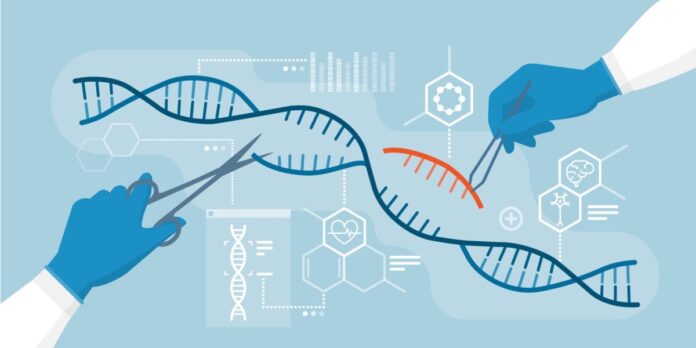
By Jessica Park
Sickle cell disease (SCD), though rare with fewer than 200,000 cases in the United States, stands as the most common and clinically significant inherited blood disorder nationwide. SCD treatment includes medications, transfusions, blood and marrow transplant and gene therapy. Recently, the Food and Drug Administration (FDA) approved the first two gene-editing therapies to treat sickle cell disease.
What is sickle cell disease? It is a hemoglobin disorder wherein hemoglobin, the protein inside red blood cells that transports oxygen from the lungs to the rest of the body, undergoes abnormalities. When the hemoglobin in red blood cells is broken down, it causes red blood cells to become misshapen and turn into a crescent shape. Normal red blood cells are round and flexible, allowing them to move easily through small blood vessels (capillaries) in our body to deliver oxygen to our organs and tissues. However, in sickle cell disease, red blood cells stiffen, changing shape into sickle (crescent-shaped). The altered sickle-shaped cells hinder their passage through blood vessels, leading to complications in individuals due to the interaction of abnormal red blood cells with normal ones.
What are common symptoms? Symptoms typically become apparent when a child is about 5 to 6 months old. Some people have mild symptoms, while others develop more serious complications depending on the percentage of sickle cells in the blood. Common symptoms include: Frequent pain episodes: These can affects the chest, back, legs and arms most often; Swelling and inflammation of their joints; Painful swelling of their hands and feet; Anemia, causing fatigue, paleness and weakness; Jaundice (yellowing of their skin and the whites of their eyes). SCD is rooted in a genetic mutation in the Hemoglobin Beta (HBB) gene. People with SCD received two mutated HBB genes coded for abnormal hemoglobin, one from each parent. Approximately one in every 365 Black or African American births is affected, with about one in 13 carrying the sickle cell trait, likely due to the abundance of malaria in districts where these peoples come from.
What is the current treatment for sickle cell disease? Sickle cell disease treatment includes medications, transfusions, blood and marrow transplant and gene therapy. SCD treatment may begin with antibiotics. Newborns with severe SCD will receive antibiotics twice a day until they’re 5 years old to prevent infection. Most people with SCD use medications like Voxelotor, Crizanlizumab, Hydroxyurea, and L-glutamine to make their disease less severe and treat symptoms. Blood Transfusions come in two types: Acute transfusions (the administration of blood or blood products to a person in a relatively short period and Red blood cell transfusions to help increase the number of red blood cells and provide normal, non-sickled red blood cells. Stem cell transplant (also known as blood or marrow transplant) requires a well-matched donor, often a sibling. Gene therapy changes specific segments of DNA, facilitating the creation of new healthy hemoglobin. This calls for either correcting an abnormal hemoglobin gene or putting a normal hemoglobin gene into an individual’s stem cells.
What are first FDA-approved Gene Therapies? The U.S. FDA has approved the first gene therapies to treat patients with SCD. Casgevy and Lyfgenia have received landmark approval today, marking significant progress as the first cell-based gene therapies for the SDC treatment in patients 12 years and older and a history of vaso-occlusive events. The accompanying image below provides an overview of the general procedure. Casgevy, a cell-based gene therapy, uses the groundbreaking gene-editing technology to modify DNA related to SCD. CRISPR/Cas9 technology is used to precisely edit DNA in hematopoietic (blood) stem cells. This method involves the targeted cutting of DNA, facilitating accurate DNA editing by removal, addition, or replacement. The modified blood stem cells are subsequently transplanted back into the patient, where they engraft (attach and multiply) within the bone marrow, leading to an increased production of fetal hemoglobin. Lyfgenia uses a lentiviral vector as a gene delivery vehicle for genetic modification. With Lyfgenia, the patient’s blood stem cells are genetically modified to produce HbAT87Q, or hemoglobin A, which is the normal adult hemoglobin produced in persons not affected by SCD. Red blood cells containing HbAT87Q have a lower risk of sickling and occluding blood flow. These modified stem cells are then delivered to the patient. Both Casgevy and Lyfgenia utilize the patients’ own blood stem cells, which are modified and administered as a one-time, single-dose infusion during a hematopoietic (blood) stem cell transplant. Before treatment, a patients’ own stem cells are collected, and then the patient must undergo myeloablative conditioning (high-dose chemotherapy), a process that removes cells from the bone marrow so they can be replaced with the modified cells in Casgevy and Lyfgenia. Beforehand, traditional gene therapies do not directly address the sickle cell mutation, but the new gene therapies focus on modifying patient’s blood stem cells to enhance the specific forms of hemoglobin that will prevent blood from retaining a sickle-like shape.
Questions to consider: According to researchers, it is important that we view gene therapy, for now, as transformative therapy, not a cure, as cures would mean that we would be entirely free from any side effects of the presence of the disease in our body. Although the therapy dramatically reduces vaso-occlusive pain crisis and improves the quality of life of individuals with SCD, there is not enough data yet to know this of the current gene therapies. What questions do you have about the new treatment? As we navigate the forefront of advancements, we could be among the leaders shaping the future of sickle cell treatment. Our curiosity and insights may play a significant role in this transformative adventure in the future.
